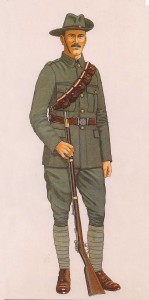Uniforms and flags of the Volunteers and Irish Citizen Army
Published in Editorial, Issue 6 (November/December 2015), Volume 23Both the Volunteers and the Irish Citizen Army (ICA) members wore uniforms of varying colours. Messrs Morrogh Brothers of Douglas Woollen Mills, Cork, were the official suppliers of cloth for the uniforms of the Volunteers. They provided a ‘high-class uniform serge of a gray-green cloth of a very suitable colour for field work in Ireland … The uniform consists of tunic with a rolled collar, two-buttoned knickers and puttees.’ The first contract to supply the uniforms was awarded to the Limerick Clothing Factory. Owing to inadequate financial resources, the provision of uniforms to the Volunteers was not possible; uniforms were made on an individual basis by a number of tailors, and this produced a variety of styles and colours.
Eoin MacNeill designed the Volunteers’ cap badge: ‘The letters FF represent Fianna Fáil, the legendary first standing army of Ireland. Neither sunburst nor any other symbolic theme underlay the choice of an 8-pointed star with its flamiform accompaniment.’ Other ranks wore the badge in bronze, and officers wore it in white metal. Officers of the Dublin Brigade wore a badge with the inscription ‘Drong Átha Claith’.
As a body, the Irish Citizen Army was particularly well uniformed, and most of the ICA wore a complete uniform. Messrs Arnott were the official suppliers to the ICA. Captain Jack White made the original order for 50 uniforms. They were of a darker green than the Volunteers’ uniforms, and their Cronje hat (named after the Boer general) usually had the left side fastened up with the Red Hand badge of the Irish Transport and General Workers’ Union.

A typical Volunteer in uniform, as sketched by B. Younghusband in Irish Volunteer Soldier 1913–23 (Osprey Publishing, 2003).
The Plough-and-the-Stars was the official flag of the Irish Citizen Army; George Russell (Æ) suggested the emblem. The flag had a green background (changed to blue in 1943) with a plough and seven stars imposed on it, the plough and the stars symbolising the present and the future of the working class respectively. R.M. Fox wrote:
‘In the interests of historical accuracy it should be noted that the original Starry Plough banner—now in the National Museum—is of green poplin with a design of a plough in yellow outlined in black. There are seven eight-pointed stars. This banner was missing for years and—in the meantime—the accepted version of the flag was that of a blue background formed of silver stars.’
The Volunteers often flew a green flag with the Irish harp but without the crown. Thomas Francis Meagher, of Young Ireland, designed the tricolour of green, white and orange in 1848, and presented it to the citizens of Dublin. John Mitchel of Young Ireland said: ‘I hope to see that flag one day waving as our national emblem’. It was seldom flown before the Rising, but was confirmed by Article 7 of the 1937 Irish Constitution as the official flag of the Irish state.
Joseph E.A. Connell Jr is the author of Who’s who in the Dublin Rising 1916 (Wordwell Books, 2015).
Further reading
J. Durney, The Volunteer: uniforms, weapons, and history of the Irish Republican Army, 1913–1917 (Naas, 2004).
R.M. Fox, History of the Irish Citizen Army (Dublin, 1944).
Walpole, Robert: Witness Statement 218.
Read More: Flags flown in Dublin during the Rising
















